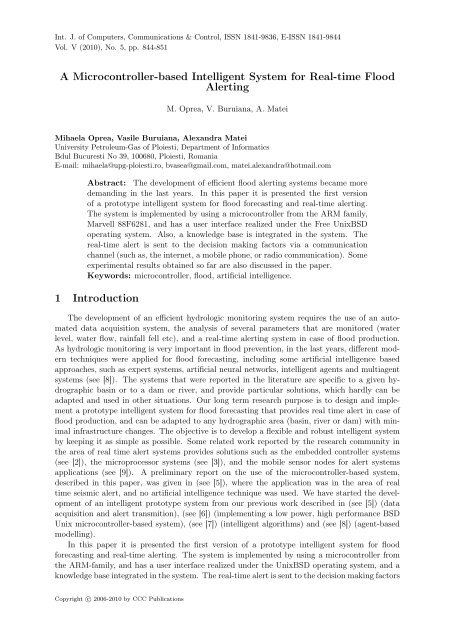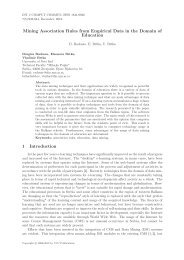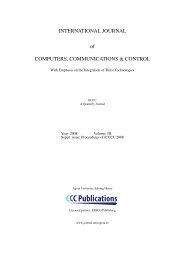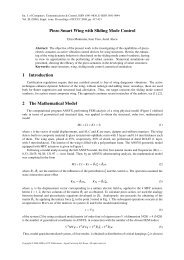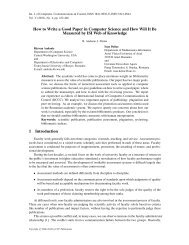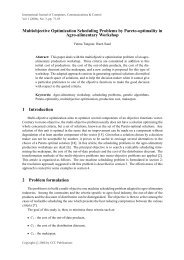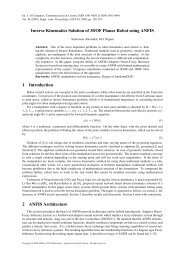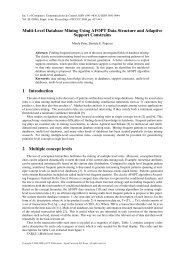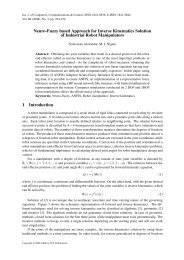A Microcontroller-based Intelligent System for Real-time Flood ...
A Microcontroller-based Intelligent System for Real-time Flood ...
A Microcontroller-based Intelligent System for Real-time Flood ...
Create successful ePaper yourself
Turn your PDF publications into a flip-book with our unique Google optimized e-Paper software.
Int. J. of Computers, Communications & Control, ISSN 1841-9836, E-ISSN 1841-9844<br />
Vol. V (2010), No. 5, pp. 844-851<br />
A <strong>Microcontroller</strong>-<strong>based</strong> <strong>Intelligent</strong> <strong>System</strong> <strong>for</strong> <strong>Real</strong>-<strong>time</strong> <strong>Flood</strong><br />
Alerting<br />
M. Oprea, V. Buruiana, A. Matei<br />
Mihaela Oprea, Vasile Buruiana, Alexandra Matei<br />
University Petroleum-Gas of Ploiesti, Department of In<strong>for</strong>matics<br />
Bdul Bucuresti No 39, 100680, Ploiesti, Romania<br />
E-mail: mihaela@upg-ploiesti.ro, bvasea@gmail.com, matei.alexandra@hotmail.com<br />
Abstract: The development of efficient flood alerting systems became more<br />
demanding in the last years. In this paper it is presented the first version<br />
of a prototype intelligent system <strong>for</strong> flood <strong>for</strong>ecasting and real-<strong>time</strong> alerting.<br />
The system is implemented by using a microcontroller from the ARM family,<br />
Marvell 88F6281, and has a user interface realized under the Free UnixBSD<br />
operating system. Also, a knowledge base is integrated in the system. The<br />
real-<strong>time</strong> alert is sent to the decision making factors via a communication<br />
channel (such as, the internet, a mobile phone, or radio communication). Some<br />
experimental results obtained so far are also discussed in the paper.<br />
Keywords: microcontroller, flood, artificial intelligence.<br />
1 Introduction<br />
The development of an efficient hydrologic monitoring system requires the use of an automated<br />
data acquisition system, the analysis of several parameters that are monitored (water<br />
level, water flow, rainfall fell etc), and a real-<strong>time</strong> alerting system in case of flood production.<br />
As hydrologic monitoring is very important in flood prevention, in the last years, different modern<br />
techniques were applied <strong>for</strong> flood <strong>for</strong>ecasting, including some artificial intelligence <strong>based</strong><br />
approaches, such as expert systems, artificial neural networks, intelligent agents and multiagent<br />
systems (see [8]). The systems that were reported in the literature are specific to a given hydrographic<br />
basin or to a dam or river, and provide particular solutions, which hardly can be<br />
adapted and used in other situations. Our long term research purpose is to design and implement<br />
a prototype intelligent system <strong>for</strong> flood <strong>for</strong>ecasting that provides real <strong>time</strong> alert in case of<br />
flood production, and can be adapted to any hydrographic area (basin, river or dam) with minimal<br />
infrastructure changes. The objective is to develop a flexible and robust intelligent system<br />
by keeping it as simple as possible. Some related work reported by the research community in<br />
the area of real <strong>time</strong> alert systems provides solutions such as the embedded controller systems<br />
(see [2]), the microprocessor systems (see [3]), and the mobile sensor nodes <strong>for</strong> alert systems<br />
applications (see [9]). A preliminary report on the use of the microcontroller-<strong>based</strong> system,<br />
described in this paper, was given in (see [5]), where the application was in the area of real<br />
<strong>time</strong> seismic alert, and no artificial intelligence technique was used. We have started the development<br />
of an intelligent prototype system from our previous work described in (see [5]) (data<br />
acquisition and alert transmition), (see [6]) (implementing a low power, high per<strong>for</strong>mance BSD<br />
Unix microcontroller-<strong>based</strong> system), (see [7]) (intelligent algorithms) and (see [8]) (agent-<strong>based</strong><br />
modelling).<br />
In this paper it is presented the first version of a prototype intelligent system <strong>for</strong> flood<br />
<strong>for</strong>ecasting and real-<strong>time</strong> alerting. The system is implemented by using a microcontroller from<br />
the ARM-family, and has a user interface realized under the UnixBSD operating system, and a<br />
knowledge base integrated in the system. The real-<strong>time</strong> alert is sent to the decision making factors<br />
Copyright c○ 2006-2010 by CCC Publications
A <strong>Microcontroller</strong>-<strong>based</strong> <strong>Intelligent</strong> <strong>System</strong> <strong>for</strong> <strong>Real</strong>-<strong>time</strong> <strong>Flood</strong> Alerting 845<br />
via Internet or mobile phone or by radio communication. The experimental results obtained so<br />
far are also discussed in the paper.<br />
2 The architecture of the microcontroller-<strong>based</strong> intelligent system<br />
The microcontroller-<strong>based</strong> intelligent system was designed arround the Marvell 88F6281 microcontroller<br />
by using the Marvell Sheevaplug development plat<strong>for</strong>m (see [11]) , and the Unix Free<br />
BSD 8.0 Beta 2 operating system (OS) (see [12]) . The architecture of the system is presented<br />
in figure 1.<br />
Figure 1: The architecture of the system<br />
As interfaces with the environment, the intelligent system has a data acquisition system<br />
(DAS), and an alert transmission system (ATS), both systems being developed within the microcontroller<br />
Marvel 88F6281. The data acquisition system takes the measurements of different<br />
parameters that are monitored from a variety of sensors (Si) and measurement devices (e.g. rain<br />
gauges). The alert transmission system will send the hydrologic alert code through a communication<br />
channel (internet, radio or mobile phone) to the decision factors. We have included also in<br />
the microcontroller a data processing module, a knowledge base, and an analysis module, those<br />
<strong>based</strong> on the knowledge of the intelligent system will provide the hydrologic alert code to ATS.<br />
The microcontroller 88F6281 is built under the SoC <strong>for</strong>m, i.e. system on chip, and has a large<br />
variety of interfaces as shown in figure 2. Its main destination is the mobile telephone market<br />
due to its mul<strong>time</strong>dia facilities.<br />
We have compiled on this system the Unix FreeBSD 8.0 operating system, available in the beta<br />
version, due to its stability and simple programming (see [4]). This OS provides support <strong>for</strong> the<br />
ARM9 architecture, and it was compiled with the specifications of the 88F6281 microcontroller<br />
according to (see [6]). Moreover, the OS that was chosen is a good option <strong>for</strong> embedded real<br />
<strong>time</strong> applications (see [1]).<br />
The hydrologic alert transmission could be sent by email, SMS (on the mobile phone) or by<br />
radio transmission (e.g. to a PDA - Personal Digital Assistant).<br />
3 Hydrographic monitoring and analysis system<br />
The monitoring and analysis system of a catchment basin structure consists by a complex of<br />
sensors that acquire in<strong>for</strong>mation about the monitored river parameters, as well as rainfalls in the<br />
catchment area. Another important set of in<strong>for</strong>mation is given by the catchment physiographic
846 M. Oprea, V. Buruiana, A. Matei<br />
Figure 2: The Marvell Sheeva 88F6281 interfacing options<br />
characteristics that influence the flow regime during the flood (see [10]). Our hydrographic<br />
monitoring and analysis system was designed <strong>for</strong> the monitoring of the evolution process of<br />
rainfall trans<strong>for</strong>mations into collecting streams by the hydrographic network from one river basin.<br />
The system is able to acquire and store the database in<strong>for</strong>mation on river water level (H), current<br />
river speed (v), water flow rates (Q), the rainfalls level and frequency (X) etc and transmit them<br />
to higher level of the analysis tasks. After the in<strong>for</strong>mation processing is done by using the<br />
analysis algorithms (see [7]), the system has the ability to make decisions and to transmit alerts<br />
to the Committee of Emergency Situations in case of flood risks.<br />
The input data used by the system can be obtained from parameters measurements <strong>time</strong>series.<br />
The analyzed parameters are as follows:<br />
• the river water level (H - cm), measured by the gauging stations that are located in different<br />
regions of the catchment;<br />
• the rainfalls quantity (X - l/m 2 );<br />
• the river water velocity (v - m/s);<br />
• the air temperature (T - o C);<br />
• the depth (a), width (L) and slope (p) of the river;<br />
• the thickness of the ice/snow (G - cm).<br />
The output of the system is given by the numerical expressions that characterize the interdependence<br />
of the hydrological process and the factors that determine it: the maximum flow rate<br />
(Qmax) and the average precipitation. The main steps followed by the hydrographic monitoring<br />
and analysis system are given bellow.<br />
1. parameters_measurement (H, Q, X, v, T, a, l, p, G);<br />
2. parameters_processing (H, X);<br />
3. parameters_transmission (Xaverage);<br />
4. parameters_analysis (); // use of the knowledge base
A <strong>Microcontroller</strong>-<strong>based</strong> <strong>Intelligent</strong> <strong>System</strong> <strong>for</strong> <strong>Real</strong>-<strong>time</strong> <strong>Flood</strong> Alerting 847<br />
5. IF flood_risk = yes THEN<br />
(a) hydrologic alert code transmission.<br />
The parameters measurement step requires periodic measurements of specific parameters<br />
such as water flow, water level, river flow rate, temperatures. The equipment used <strong>for</strong> per<strong>for</strong>mance<br />
measurements and processing of hydrological parameters of the water courses are the<br />
gauging stations. The instrumentation used <strong>for</strong> parameters measuring vary from groom gauging,<br />
pluviometric devices to measure the rainfall, river ratchets gauging <strong>for</strong> speed measurements, to<br />
automatic instrumentation that can measure most of the hydrological parameters that are monitored.<br />
The parameters processing step involves the <strong>for</strong>m factor computing <strong>for</strong> each sub-catchment<br />
coefficient of flood <strong>for</strong>m, and the determination of the coefficient of leakage in the warning subbasins.<br />
The parameters transmission step is realized through a communication channel, such as<br />
internet, radio or mobile phone. The parameters analysis step is the most important step because<br />
the subsequent correct decisions are taken in case of flood waves. It consists in the following<br />
three steps:<br />
1.<br />
• determination of the average level of precipitations;<br />
• calculation of the maximum flow in each sub-basin of the downstream warning sub-basins;<br />
• <strong>based</strong> on the calculations made in the previous two steps, the system analyses the risk of<br />
flood production by using the rules from the knowledge base that is incorporated in the<br />
intelligent system; the rules are given the hydrological alert code (yellow, orange and red).<br />
As an example, the main characteristics of the knowledge <strong>based</strong> system are presented in Table<br />
Table 1: The rules of the knowledge base (selection)<br />
RULE 1 IF flow < attention AND precipitations < 40l/m 2 THEN hydrologic_code = green;<br />
RULE 2 IF flow ≥ attention AND flow < alert AND precipitations < 40l/m 2 THEN<br />
flood_risk = YES AND hydrologic_code = yellow;<br />
RULE 3 IF flow ≥ attention AND flow < alert AND precipitations > 40l/m 2 THEN<br />
flood_risk = YES AND hydrologic_code = orange;<br />
RULE 4 IF flow ≥ alert AND flow < danger AND precipitations < 40l/m 2 THEN flood_risk<br />
= YES AND hydrologic_code = orange;<br />
RULE 5 IF flow ≥ alert AND flow < danger AND precipitations > 40l/m 2 THEN flood_risk<br />
= YES AND hydrologic_code = red;<br />
RULE 6 IF flow ≥ danger THEN flood_risk = YES AND hydrologic_code = red;<br />
The precipitations are occurring predominantly as rain or snow. The fall of rain is the largest<br />
factor contributing to increased river flows. Snow versus rain is the second source of precipitation.<br />
Melting snow during spring has a considerable impact on river basin management. Tracking the<br />
level and the periodicity of precipitation involves measuring them by using existing sensors<br />
and transducers gauging stations. Warning about the risk of flood is used to take appropriate<br />
decisions from the analysis of all in<strong>for</strong>mation related to the maximum river flow. If the analysis<br />
step indicates a possible flood production then the prevention system will send signals to the<br />
members of the Emergency Situations Committee. The hydrological alert (containing the alarm<br />
severity code of flooding) can be transmitted online to PDAs, smart terminals with a GPS and
848 M. Oprea, V. Buruiana, A. Matei<br />
Figure 3: The structure of the monitoring and analysis system<br />
GPRS (General Packet Radio Service) or Internet. In figure 3 it is shown the structure of the<br />
monitoring and analysis system <strong>for</strong> a catchment river basin.<br />
X1, X2, . .., Xn are the rainfalls in each sub-catchment;<br />
H1, H2, . .., Hn are the rivers level.<br />
The system meets three important functions:<br />
• the function of monitoring the evolution of the hydrographic basin - real <strong>time</strong> measuring<br />
of the river level and rainfall level and periodicity;<br />
• the analysis function - parameters processing and comparing them with the references<br />
parameters of the catchment;<br />
• the decision and warning function.<br />
4 Experimental results of flood alerting case study<br />
As a case study we have experimented the microcontroller-<strong>based</strong> intelligent system <strong>for</strong> flood<br />
alerting in the Prahova catchment basin presented in figure 4. The hydrographic network <strong>for</strong>ms<br />
a highly developed basin in a palm <strong>for</strong>m flowing NW-SE. The main rivers that compose the<br />
Prahova sub-basin are the Prahova river and its main tributaries: Azuga, Doftana, Teleajen,<br />
and Cricovul Sarat. The water recources in the Prahova country have increased significantly<br />
due to two large lakes, Paltinu (Doftanei Valley) and Maneciu-Streams (Teleajen Valley). The<br />
Prahova river is the largest collection of water in the Prahova county, with a length of 193 km,<br />
of which the first 6 km and the last 16 km are located in the counties Brasov and Ilfov.<br />
The Prahova river basin is characterized by three types of climates: mountain, hill, and plain.<br />
The annual quantity of precipitation is 1000-1400 mm in the mountains, 500-1000 mm in the<br />
hills, and 550-600 mm in the plain. Summer rainfall is more abundant, where the flood may<br />
occur in the gauging stations deepened Moara Domneasca and Adancata. For the visualization<br />
of the hydrological process evolution in <strong>time</strong> we have used the program Multi Router Trafic<br />
Grapher (mrtg) that generates graphics as a function of <strong>time</strong>. An example of Prahova river level<br />
evolution and flow in 24 hours during 7 days is given in figure 5.<br />
For the Prahova hydrometric station the attention (ATC), alert (AC) and danger (DC) cotes<br />
<strong>for</strong> the rivers level are the following: ATC = 250 cm, AC = 350 cm and DC = 400 cm and <strong>for</strong><br />
water flow are: ATC = 105 m 3 /s, AC = 230 m 3 /s and DC = 320 m 3 /s. Our research goal was<br />
to use the microcontroller-<strong>based</strong> intelligent system, that was presented in the previous sections,
A <strong>Microcontroller</strong>-<strong>based</strong> <strong>Intelligent</strong> <strong>System</strong> <strong>for</strong> <strong>Real</strong>-<strong>time</strong> <strong>Flood</strong> Alerting 849<br />
Figure 4: The Prahova catchment basin<br />
Figure 5: The evolution of Prahova river level and flow in 24 hours during 7 days<br />
<strong>for</strong> the Prahova river basin with the purpose of sending warning in real <strong>time</strong> to the Emergency<br />
Situations Committee, and to the possible affected population in case of flood waves.<br />
In the experiments that were run so far, the data acquisition was simulated. The experiments<br />
made so far used <strong>for</strong> alert transmission two Motorola MX300 radio transmission stations, those<br />
were modified to work in the 146 MHz bandwidth. Figure 6 shows the Motorola MX300 radio<br />
stations that were used.<br />
Figure 6: The two Motorola MX300 radio stations<br />
The main characteristics of the radio stations are that they can be automatically activated<br />
when they receive a radio signal through the incorporated microphone or through the microphone<br />
input. There<strong>for</strong>e, the sound output of the microcontroller-<strong>based</strong> system was connected to the<br />
microphone input of the transmitter and according to the hydrologic alert code provided by the<br />
analysis module will run audio alert records according to following script:<br />
The evolution of the simulated hydrological process is shown on the microcontroller-<strong>based</strong>
850 M. Oprea, V. Buruiana, A. Matei<br />
♯ !/bin/bash<br />
♯ script receives argument via parameter {$1} which is received at startup <strong>time</strong>.<br />
♯ {$1} may be as following: ’green’, ’yellow’, ’orange’, ’red’ and are sent on via the<br />
main program<br />
♯ alert on system console echo "Alerting code - {$1}. Activating radio transmitter"<br />
♯record alert via syslog (unix system logger) echo " ‘date |cut -c1-19‘: Receiving<br />
alerting code {$1} |logger -s -<br />
♯playing one of the audio files: ’green.wav’, ’yellow.wav’, ’orange.wav’, ’red.wav’<br />
/usr/local/bin/esdplay -s localhost {$1}.wav<br />
intelligent system screen as shown in figure 7. Three hydrometric gauging stations were included<br />
in the simulation, Buşteni, Cîmpina and Prahova, all <strong>for</strong> the Prahova river basin.<br />
Figure 7: Rain/Level/Flow evolution <strong>for</strong> the<br />
case study<br />
Figure 8: The experimental system<br />
Figure 8 shows the experimental system. In the experiments made, <strong>for</strong> each hydrological<br />
alert code it was sent via radio communication the corresponding audio alert signal (attention,<br />
alert and danger), according to the results of the analysis step.<br />
5 Conclusions<br />
As most of the hydrological processes require real <strong>time</strong> monitoring and online alerting, we<br />
have developed a microcontroller-<strong>based</strong> intelligent system that can be connected to various sensors<br />
and measuring devices <strong>for</strong> hydrological parameters measurements, and can transmit online<br />
hydrological alert codes to the decision making factor (such as Emergency Situations Committee<br />
that exist in each county from Romania). The system can be adapted to any hydrographic basin<br />
with minimal changes in its configuration. At the <strong>time</strong> the system was developed, all the data<br />
coming in was simulated, but at any <strong>time</strong> its knowledge base system can be fed with data coming<br />
from real sensors. During long <strong>time</strong> hard condition tests under simulated air humidity, simulated<br />
power fluctuations, while running a CPU stress testing program and also our simulation software,<br />
the intelligent system kept its main characteristics of flexibility and robustness, as no indicators<br />
of system failure have occurred at Unix FreeBSD 8.0 operating system kernel level. As a future<br />
work we shall extend our experiments by using simultaneously with the radio hydrological alert<br />
transmission other communication channels such as the internet (by sending an e-mail) and the
A <strong>Microcontroller</strong>-<strong>based</strong> <strong>Intelligent</strong> <strong>System</strong> <strong>for</strong> <strong>Real</strong>-<strong>time</strong> <strong>Flood</strong> Alerting 851<br />
mobile phone (by sending a SMS). Also, we shall analyze some complex hydrological situations<br />
by taking into account the interdependencies between different rivers flows and levels from a<br />
hydrographic basin and the meteorological <strong>for</strong>ecasts, improving flood prevention due to an early<br />
hydrological alert sent to the decision making factors in order to take more efficient prevention<br />
measurements.<br />
Bibliography<br />
[1] D. Abbot, Linux <strong>for</strong> embedded real-<strong>time</strong> applications, Newnes, USA, 2003.<br />
[2] K. Arnold, Embedded controller hardware design, LLH Technology Publishing, USA, 2001.<br />
[3] S. R. Ball, Embedded microprocessor systems - real world design, 3rd edition, Newnes, USA,<br />
2002.<br />
[4] BSDi, The FreeBSD Handbook, Berkeley University of Cali<strong>for</strong>nia, USA, 2000.<br />
[5] V. Buruiana, Wireless Seismic Sensor, Proceedings of Process Control Symposium SPC-09,<br />
Ploiesti, 2009.<br />
[6] V. Buruiana, Experimental Research regarding the Development of a <strong>Microcontroller</strong>-Based<br />
<strong>Intelligent</strong> Monitoring and Alert <strong>System</strong>, Research Report, University Petroleum-Gas of<br />
Ploiesti, Department of In<strong>for</strong>matics, 2009.<br />
[7] A. Matei, <strong>Intelligent</strong> Algorithms <strong>for</strong> Hydrographic Monitoring, Analysis and Prediction, Research<br />
Report, University Petroleum-Gas of Ploiesti, Department of In<strong>for</strong>matics, 2009.<br />
[8] M. Oprea, A. Matei, E. Petre, Agent-<strong>based</strong> Modeling of a Dam Monitoring <strong>System</strong>, Proceedings<br />
of 17th International Conference on Control <strong>System</strong>s and Computer Science - CSCS<br />
2009, Politehnica Press, 509-514, 2009.<br />
[9] D. Popescu, R. Varbanescu, A. Iordan, S. Arghir, Interconnection of mobile sensor nodes <strong>for</strong><br />
alert system applications, Proceedings of CSCS 2009, Politehnica Press, Bucharest, 249-254,<br />
2009.<br />
[10] I. Watson, A. D. Burnett, Hydrology - An Environmental Approach, Taylor & Francis, CRC<br />
Press, 1995.<br />
[11] http://www.tgdaily.com/hardware-opinion/41525-marvells-plug-computer-a-tiny-discretefully-functional-5-watt-linux-server<br />
[12] ftp://ftp.freebsd.org/pub/FreeBSD/ISO-IMAGES-i386/8.0/8.0-RC2-i386-disc1.iso


